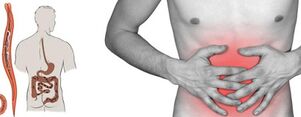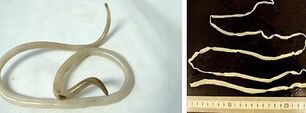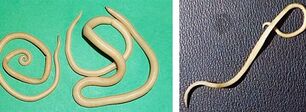
As you know, parasites are considered the most resistant organisms to the external environment. To date, about 250 species are recognized as helminths suitable for infecting humans. Each poses a threat to health and, in more severe cases, to the lives of those infected. Knowing the types and characteristics of human helminths will greatly facilitate treatment and help develop an effective prevention plan.
What worms do people have?
It takes a long time to fully understand the types of worms. The fact that so far scientists have not been able to provide the most detailed information on the classification of parasites. This is largely due to the fact that a certain area is characterized by the presence of specific helminthic invasions. In this regard, it is almost impossible to obtain data on all types of human helminths existing on Earth.
Thus, the worms most commonly diagnosed in the southern zone are virtually non-existent in the population of the northern geographical regions. In the temperate climate zone and in the middle latitudes, about 20 species of worms are recognized as the most common. They can be categorized into 3 main categories:
- Round parasitic worms (nematodes).
- Ribbon helmets (cestodes).
- Flat worms (trematodes).
1. Round and flat helmets
Each of the above groups contains a huge number of parasitic organisms that require a brief description. In children and adults, the following are the most commonly treated worms belonging to the class of trematodes:
- Chinese Fluke;
- cat beetle;
- liver beetle.
7 of the nematodes are the most famous and widespread parasitic species that inhabit the body of any age. The roundworms that are transmitted in any way are:
- pinworms;
- globular worm;
- intestinal acne;
- whipworm;
- Trichinella;
- trichostrongylides;
- hookworms.
2. Cestode invasions
Tapeworms (or cestodes) are parasitic worms that pose the greatest threat to the body. Diagnosis of such helminthic infections is much less common than infection with round parasites in children and adults, however, infection with the following types of worms has the most severe consequences:
- bullish tapeworm;
- dwarf tapeworm;
- porcine tapeworm;
- wide ribbon;
- echinococcus;
- rat tapeworm.
Acanthocephalus is one of the rarest types of helminthic invasions. These include the giant ridge and the beaded ridge. Such worms are rarely able to enter the body, for example when consuming an insect or larvae infected with parasites.
Why are worms dangerous to humans?
In order to properly assess the degree of risk to a patient's health in the case of helminth colony, the worms to which they belong must first be determined. The treatment and its duration depends on the type of worms. The main damage resulting from the presence of parasites in the body is felt in the intestines - most of all helminths are localized in this organ. All nutrients that need to be absorbed and should be beneficial to humans are excreted by worms.
Meanwhile, other types of worms don’t just settle in the intestines and “steal” all the necessary trace elements from humans. They actively reproduce and affect human vital organs and systems. In addition to the heart muscle, liver, and lungs, worms can cause massive damage to the brain and blood vessels. Worms can even infect the eyes.
The main ways of worm infection

You can protect yourself and your loved ones from developing the disease if you know how helminths of a particular species get into the body. This is the only way to take all the necessary measures in time and minimize the risk of infection. The main routes of propagation are known as:
- Infection occurs through soil and water. If you walk barefoot on the ground, the risk of laying eggs inside increases several times. It is an uncontrolled source of drinking, and in some cases even water from a shared water supply can contain worm larvae.
- Helminth eggs enter the body together with products of animal origin. Helminthic invasions result in insufficient or poor quality processing of meat, fish, seafood, eggs. People who prefer exotic Asian cuisine are at risk of being infected by worms. He, sushi, sashimi is based on raw fish and meat.
- Certain types of parasites can settle in the intestines after being put in with unwashed vegetables and fruits. Rejection of animal products does not resolve the likelihood of developing helminthiasis. Eggs of worms, as already mentioned, may be in the soil. It is recommended to boil water on all fruits before use.
- Worms spread to humans and animals. Pets do not often become a source of infection for their owners. However, worms are found both inside the animal and on its fur. From dogs and cats, the eggs of parasites fall into the soil and spread further with melt water.
Spreading parasites from sick people
Worms can also move from one infected person to another. There are several ways to transmit helminthic invasions:
- through unwashed hands (e. g. handshake, hug);
- when using ordinary utensils;
- if someone else is wearing underwear;
- Group application of personal care products by several people.
Pinworm eggs most often pass from person to person, often falling under the nail plates, lingering there for a long time. The spread of these types of worms in children is explained by the neglect of the basic rules of cleanliness. The child can simply pull his hand into his mouth or bite his nails, so pinworms have no difficulty penetrating a new human body. The role of parents at this stage is to recognize the signs of helminthiasis in a timely manner and to prevent the development of helminthic invasions in their infant, starting treatment for the disease immediately.
Symptoms of the acute stage of helminthiasis
It is not easy to detect early signs of a parasitic infection in an adult or child. Diagnosis of the presence of worms is complicated by the fact that the incubation period of some species can take up to one and a half years.
As a general rule, the first symptoms of a worm infection appear after different periods. In addition, the course of helminthiasis can be conditionally divided into 2 stages:

- acute stage (on average up to two months after the incubation period);
- is chronic (characterized by the development of mature parasites and can last for decades).
In the acute phase of invasion, the main, clearly expressed symptom can be called an allergic reaction. As a result of antibodies formed during the migration of parasitic larvae, abnormal manifestations on the skin should be alerted. The following symptoms of any worm infection in humans are:
- skin hyperemia;
- burning sensation and itching;
- small rashes on the surface of the epidermis or mucous membranes;
- slight increase in lymph nodes;
- local swelling;
- sternal pain (up to suffocation attacks);
- vomiting and persistent nausea;
- diarrhea or constipation.
In addition, dangerous diseases such as pneumonia, meningoencephalitis, hepatitis, and other creatures can become complicated.
Reliable confirmation of the presence of helminths in internal organs is an index of eosinophils in a clinical blood test. The increased value of these particles is caused by dysproteinemia - a violation of the normal numerical ratio between protein fractions.
Types of symptoms in the chronic form of the disease
Signs of human chronic helminthiasis are predetermined by the localization of parasite colonization. In simple words, the manifestations of the disease depend on which organ becomes the main habitat for a given type of worm.
Especially in the intestines of roundworms, the most common parasitism can continue without the slightest symptoms. If larger species are affected by the worms, signs of the disease become noticeable as soon as the worms reach puberty. Dyspeptic disorders, pain syndrome, and neurotic manifestations are characteristic of adults and children. Ascariasis is often characterized by the development of intestinal obstruction and inflammation of the pancreas and an increased risk of oncological diseases.
Antiparasitic drugs
Helminthiasis should be treated as early as possible. Effective therapy will be if you know exactly what parasite has settled in your body before you start. There are plenty of anthelmintics today.
These are different types of drugs that can target a specific type of worm. Stronger anthelmintics are broad-spectrum drugs and are excellent for the treatment of combined helminthiasis. Both are considered toxic and have many side effects and contraindications. The use of such drugs should be performed with extreme caution, only after medical advice.
Most types of adult worms need to be treated for a long time and persistently. Parasitologists often prescribe the concomitant use of several anthelmintic drugs.
The dosage regimen and dose of a particular drug should only be prepared by a professional. This will help you avoid allergies and serious side effects. For certain types of helminthic infections, treatment should be repeated. This is often due to the fact that during the first therapy, most of the adult worms were neutralized, but certain forms of larvae and worm eggs still remain in the patient’s body. If left untreated, the worms will return.
Basic Prevention Measures
Medication is undoubtedly an important part of getting rid of parasites and, in some cases, prevention. However, to cope with invasive worms, the simplest rules for worm prevention must be followed. Treatment will not work if you ignore the following rules:
- Wash your hands often, especially after using the toilet and before eating.
- If the skin of your hands cannot be cleaned with soap, it is advisable to use a damp antibacterial wipe.
- All food should be rinsed thoroughly before cooking.
- It is important to expose meat and fish to permanent heat.
- Use only water from reliable sources for drinking.
- Worm testing is extremely important at least once a year.
















































